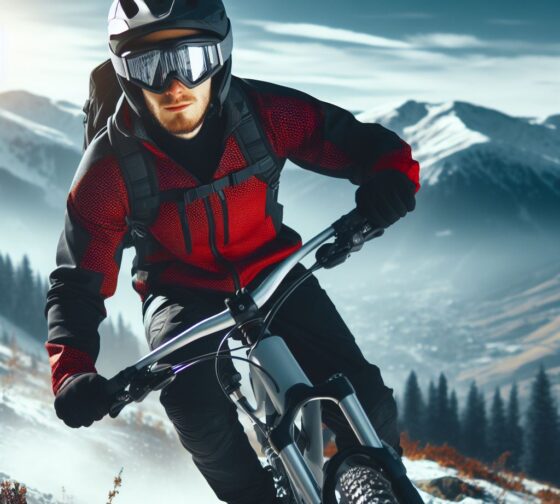Winter Mountain Biking: Embracing the Chill for Adventure
*We may earn a commission for purchases made using our links. Please see our disclosure to learn more.
Winter Mountain Biking: A Deep Dive into the Chilly Adventure
As the chilly winds usher in the winter season, there’s a distinctive thrill that envelopes the hearts of cycling enthusiasts—the allure of winter mountain biking. Beyond the snow-covered trails and frosty landscapes lies an adventure that transcends the ordinary. In the pages that follow, I invite you to explore the depths of winter mountain biking—a dynamic experience that blends the serenity of nature with the exhilaration of navigating through the frosty unknown.
Drawing from personal passion and a wealth of cycling insights, this comprehensive guide aims to unravel the secrets, strategies, and sheer joy that come with embracing winter on two wheels. Join me on this journey as we delve into the nuances of gear selection, trail mastery, and the community spirit that makes winter mountain biking an exceptional and transformative pursuit.
Choosing the Right Bike
Selecting the appropriate bike for winter conditions is a critical decision that can significantly impact your riding experience. Beyond the standard mountain bike, consider investing in a specialized winter bike, such as a fat bike. These bikes feature oversized tires that provide enhanced traction on snowy terrains, ensuring a stable and enjoyable ride. Additionally, prioritize bikes with sturdy frames, effective disc brakes, and other winter-specific features.
Here are my top five reputable mountain bike brands that are known for producing quality bikes suitable for snowy conditions:
- Fatback Bikes: Fatback is a well-known brand specializing in fat bikes, which are designed with wider tires to provide better traction in snow and other challenging terrains.
- Salsa Cycles: Salsa offers a variety of adventure bikes, including some with fat tires that perform exceptionally well in snowy conditions. Their models are known for their versatility and durability.
- Trek Bikes: Trek is a leading brand in the cycling industry, and they have a range of fat bikes suitable for winter riding. Their bikes are often praised for their quality and performance.
- Surly Bikes: Surly is renowned for its rugged and versatile bikes, including fat bikes designed to tackle snow and other challenging surfaces. They are known for their durability and robust build.
- Specialized Bicycles: Specialized is a well-established brand offering a variety of mountain bikes. Their fat bike models are designed for various terrains, making them suitable for snow-covered trails.
Before making a purchase, it’s essential to consider your specific needs, the type of terrain you’ll be riding on, and your budget. Additionally, check for the latest models and reviews to ensure you get the most up-to-date information on the best mountain bikes for snowy conditions.
Essential Gear for Winter Mountain Biking

Gearing up for winter mountain biking is a meticulous process crucial for overcoming challenges in cold temperatures and varied terrains. The focus is on strategically selecting essential gear, with insulated clothing at the forefront for effective body heat retention through careful layering. Footwear, including waterproof and insulated options, is vital, along with thermal gloves and headgear to preserve dexterity and prevent heat loss during chilly conditions. This comprehensive gear selection acts as a shield against winter elements, ensuring both comfort and control during cold-weather rides.
I recommend that safety is prioritized by incorporating high-visibility gear, especially crucial in low-light winter conditions. This not only protects riders from potential accidents but also enhances overall trail safety. The proactive approach of being conspicuous to others on the trail mitigates risks associated with reduced visibility. In essence, the thoughtful choice of insulated clothing, waterproof footwear, thermal accessories, and high-visibility gear transforms winter mountain biking into an enjoyable and secure adventure, where riders not only endure but thrive in the face of seasonal challenges.
Preparing Your Bike for Winter Mountain Biking
Before embarking on a winter biking adventure, it’s vital to prepare your bike for the unique challenges posed by cold and snowy conditions. Selecting the right tires for winter is paramount—consider those with aggressive treads for optimal traction. Regularly lubricate moving parts to prevent freezing, and adjust your bike’s suspension settings to suit the snowy terrain. Pay careful attention to tire pressure adjustments, as it directly impacts your bike’s performance on snow-covered trails.
Picking the Right Trail
Not all mountain biking trails are created equal, especially when winter transforms the landscape. Choosing the right trail is crucial for a safe and enjoyable winter biking experience. Consider factors such as elevation, difficulty level, and recent weather conditions when planning your ride. Ensure the trail is well-maintained, and check for any specific winter biking guidelines or restrictions in the area. Safety should always be a top priority.
Nutrition and Hydration
Staying fueled and hydrated during winter biking is crucial for maintaining energy levels and preventing fatigue. Pack high-energy snacks that won’t freeze, such as energy bars and nuts. Additionally, consider carrying warm beverages in an insulated flask to combat the cold. Pay attention to your body’s signals and stay ahead of dehydration, which can occur even in cold weather.
Weather Considerations
Winter weather can be unpredictable, making it essential to stay informed before heading out on a biking adventure. Monitor weather forecasts for temperature fluctuations, snowfall, and wind conditions. Different weather scenarios present varied challenges, from fresh powder to icy trails. Prepare yourself with suitable clothing layers and equipment to tackle whatever nature throws your way.
Benefits of Winter Mountain Biking
Winter mountain biking offers a wealth of physical and mental health benefits, creating a unique and invigorating experience. The crisp winter air becomes a revitalizing force, breathing new life into the body. Navigating the challenging terrains characteristic of winter trails becomes an opportunity to build endurance and resilience, fostering a robust physical condition.
Beyond the physical aspects, engaging in winter biking provides a distinctive chance to stay active and connected with nature during the colder months. This connection contributes not only to physical well-being but also to mental health, offering a refreshing and rejuvenating escape that enhances overall resilience and vitality. Winter mountain biking thus becomes a holistic activity, intertwining the thrill of outdoor adventure with the promotion of both physical and mental well-being.
Environmental Considerations
As winter bikers, we have a responsibility to preserve the pristine beauty of the natural environment. Adhere to leave-no-trace principles, respecting wildlife habitats and minimizing your impact on the trails. Choose sustainable practices such as staying on designated paths, avoiding sensitive areas, and packing out all waste. By adopting these principles, you contribute to the preservation of the winter wilderness.
Safety First

Ensuring safety takes precedence in winter mountain biking, and a few key measures can significantly enhance your overall experience. First and foremost, always wear a helmet to safeguard yourself from potential falls or collisions. This simple yet crucial piece of gear provides essential protection and should be a non-negotiable part of your biking routine. Additionally, it’s imperative to ride within your skill limits, especially when exploring new trails. By being cautious and gradually pushing your boundaries, you can maintain control and reduce the risk of accidents.
Equipping yourself with safety essentials is equally important. Carry a basic first aid kit, tailored to address potential injuries or mishaps during your rides. Having a plan for emergencies, such as knowing the nearest exit points or having a communication device, adds an extra layer of preparedness. Prioritizing safety not only safeguards your well-being but also ensures that each winter biking adventure is not only enjoyable but incident-free. By incorporating these safety measures into your biking routine, you create a secure foundation for exploring winter trails and embracing the unique challenges they offer.
Conclusion
As we wrap up this exploration of winter mountain biking, it’s evident that this sport is more than a seasonal activity—it’s a lifestyle that beckons adventurers to discover the magic of the winter wilderness. Armed with insights into choosing the right gear, mastering techniques, and fostering a sense of community, you’re now well-equipped to embark on your own winter biking odyssey.
So, as the snow-covered trails await, remember to gear up, embrace the chill, and let the rhythmic crunch of snow beneath your tires be the soundtrack to an unforgettable winter cycling adventure. Winter mountain biking isn’t just a ride; it’s a celebration of nature’s frozen beauty and a test of resilience. Also it is an opportunity to create enduring memories on the trails less traveled. May your winter rides be filled with joy, camaraderie, and the pure exhilaration of conquering the winter wonderland on two wheels.
FAQs About Winter Mountain Biking
- Is winter mountain biking safe for beginners?
- I recommend proper preparation and adherence to safety guidelines. Therefore making winter mountain biking enjoyable for riders of all skill levels.
- What type of tires is best for winter conditions?
- Wide, knobby tires with good traction are ideal for winter biking. Fat bike tires, in particular, excel in snowy terrains.
- How do I keep my water from freezing during winter rides?
- Insulating your water bottle and drinking warm beverages can help prevent freezing. Alternatively, use an insulated hydration system.
- Are there organized events for winter mountain biking?
- Yes, many regions host winter biking events, including races, group rides, and festivals. Check local cycling clubs and online forums for information.
- Can I use my regular mountain bike for winter riding?
- While possible, I recommend to use a bike with features tailored for winter conditions, such as a fat bike with wide tires for better traction.




